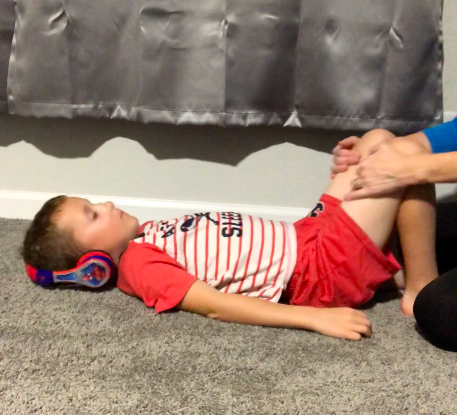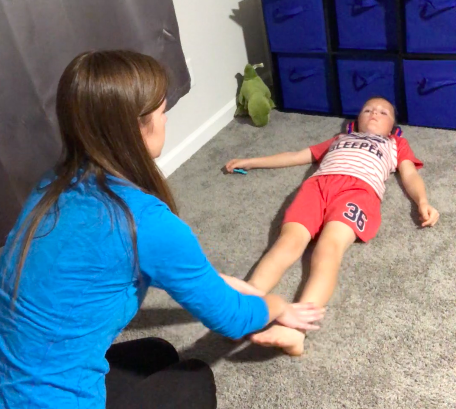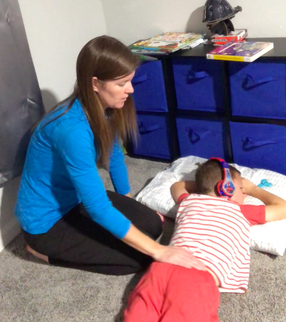The Sound & Movement Program* incorporates the Safe & Sound Protocol (SSP) and Rhythmic Movement Training (RMT) to retune the nervous system and to help mature the brainstem. The SSP is based on the Polyvagal Theory and RMT is based on Primitive Reflex Integration.
The following diagnoses, disorders, and/or delays could benefit from the Sound & Movement Program:
- ADD/ADHD-hyperactivity
- Sensory & Auditory Processing Disorders
- Autism
- Dyslexia, Dysgraphis, Dyscalculia
- Developmental & Speech Delay
- Anxiety, Fears & Phobias (including Selective Mutism)
- Behavior Challenges
- Sleep Disorders (including Bed Wetting)
- Depression
- PTSD
- Parkinson's disease
|
SOUND
|
What is the Polyvagal Theory? The Polyvagal Theory states that our nervous system is divided into three different zones due to the signals the vagus nerve is receiving form our environment and sending to our body. The first zone is the Ventral Vagal Social Engagement Zone which is where our brain and body are able to connect with others, feel calm within our environment, and our bodies can "rest and digest." The next zone is the Sympathetic Fight/Flight Zone which is when our body sends signals that we are in an environment that causes alarm. The heart rate and respiratory rate increases, digestion slows, and the body is ready to either run away from danger or fight it off. The final zone is the Dorsal Vagal Shut Down Zone which causes the body to go into survival mode - social engagement is not activated causing an inability to make eye contact, there is less attunement to the human voice, and facial muscles aren't engaged. For more information on the Polyvagal Theory, click HERE.
What happens when the Vagus Nerve isn't working effectively? If the Vagus Nerve isn't able to process the information from the environment appropriately, it can put our nervous system in a fight/flight state or a shutdown state even when there is no threat. The body perceives cues from the environment as dangerous even if there is no actual threat. The auditory system will begin to pick up more high and low frequency sounds instead of focusing on sounds within the frequencies of human voice. When the body if more focused on the high and low frequencies, the nervous system shifts into the fight/flight or freeze state. If this occurs for a sustained period of time, the body is more susceptible to illness, fatigue, depression, isolation, and more.
How does SSP help retune the nervous system? The SSP is delivered through over-the-ear headphones which activates the vagus nerve by way of the auditory system. Through systematic removal of high and low frequencies in various songs, the nervous system becomes retuned to focus on the sound frequencies that promote the nervous system to be in the Ventral Vagal Social Engagement Zone.
Why are high and low sound frequencies removed? When the brain receives signals from a high and/or low frequency sound, it puts the nervous system on alert. High frequency sounds alert the brain into thinking that someone is in danger and that danger could be coming for us next. Think of a herd of animals - when one animal in the group makes an alarm call, the others that hear it run and scatter to protect themselves. Low frequency sounds alert the brain into thinking that there may be danger nearby and we need to be alert - think of a tiger's low growl. If our brain is tuned into picking up only high and low frequency sounds, it is going to be in a fight/flight/freeze zone which is not sustainable. The nervous system must be retuned to focus on the frequencies that promote calming and connectedness.
|
MOVEMENT
|
What are innate Rhythmic Movements? These are movements babies and infants make in their first year of life that are the building blocks for the development and maturation of the brain, body, and sensory systems. Rhythmic movements stimulate new nerves to grow, nerves to form branches, produces myelin which gives nerves the ability to communicate effectively to the rest of the body and helps integrate primitive reflexes. Repetitive movements are essential to develop balance, mobility, vision, hearing, speaking, learning, and communicating. For more information and research, click HERE
What are Primitive Reflexes? Primitive Reflexes are reflexes that develop while a baby is in the mother's womb and during infancy to create automatic and instinctual movements which assist in development, growth, and survival. Primitive Reflexes merge into more sophisticated movements and typically become inactive/integrated after the toddler stage.
What can happen if Primitive Reflexes aren't integrated? When reflexes aren't integrated, the body is in a state of chronic stress due to the fight/flight/free response being triggered. Confusion within the neruo-sensory-motor system can occur which causes extra limb movements creating difficulty with growth, coordination, reading, writing, speaking, and thinking. Weak muscle tone, fatigue, muscle tension, and aches may also be due to unintegrated Primitive Reflexes.
Which types of movements are utilized in the Sound & Movement Program? Simple, passive rocking movements are done while the child is laying on their back, their side, and/or their stomach. The movements replicate the movements infants naturally do to integrate primitive reflexes. The goal is to move from a passive movement to an active movement and to get the body ready for exercises to integrate Primitive Reflexes.
What is the time commitment for this program? The ideal schedule is 10 minutes a day, 5 days a week, for 6 weeks. The program can be led by parents or in-home by a certified practitioner if you are located in Northeast Florida.
*The Sound & Movement Program is not behavior-analytic in nature and is therefore not covered by my BACB credential.


